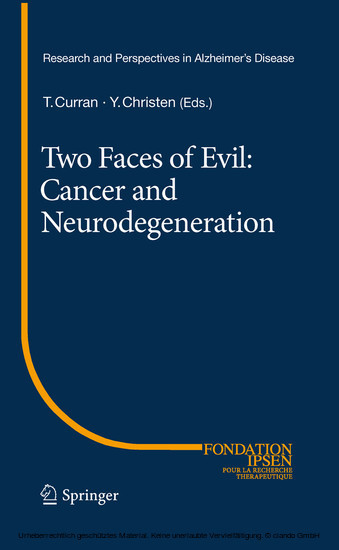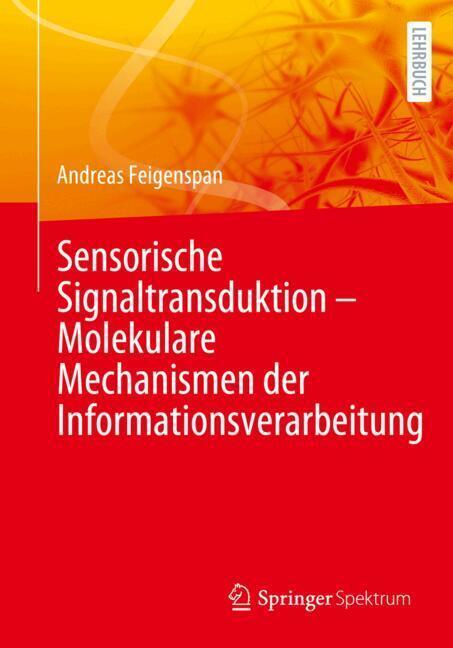Two Faces of Evil: Cancer and Neurodegeneration
Cancer and Neurodegeneration
Homeostasis involves a delicate interplay between generative and degenerative processes to maintain a stable internal environment. In biological systems, equilibrium is established and controlled through a series of negative feedback mechanisms driven by a range of signal transduction processes. Failures in these complex communication pathways result in instability leading to disease. Cancer represents a state of imbalance caused by an excess of cell proliferation. In contrast, neurodegeneration is a consequence of excessive cell loss in the nervous system. Both of these disorders exhort profound tolls on humanity and they have been subject to a great deal of research designed to ameliorate this suffering. For the most part, the topics have been viewed as distinct and rarely do opportunities arise for transdisciplinary discussions among experts in both fields. However, cancer and neurodegeneration represent yin-yang counterpoints in the regulation of cell growth, and it is reasonable to hypothesize that key regulatory events mediated by oncogenes and tumor suppressor genes in cancer may also affect neurodegenerative processes
1;Two Faces of Evil: Cancer and Neurodegeneration;3 1.1;Foreword;5 1.2;Acknowledgments;7 1.3;Contents;9 1.4;Contributors;11 1.5;Updating the Mammalian Cell Cycle: The Role of Interphase Cdks in Tissue Homeostasis and Cancer;15 1.5.1;1 Mammalian Cdks and the Classical Cell Cycle Model;17 1.5.2;2 Interphase Cdks are Not Essential for the Mammalian Cell Cycle;19 1.5.3;3 Limited Compensatory Activities Among Interphase Cdks;21 1.5.4;4 Interphase Cdks Have Evolved to Drive Proliferation of Highly Specialized Cells;24 1.5.5;5 Cell Cycle Cdks and Cancer;25 1.5.6;6 Are Interphase Cdks Required for Tumor Development?;26 1.5.7;References;29 1.6;The Role of Cdk5 as a Cell Cycle Suppressor in Post-mitotic Neurons;31 1.6.1;1 Introduction;32 1.6.2;2 Cdk5 Plays an Important Role in Neuronal Development;32 1.6.3;3 Cdk5 Serves Important Functions in the Regulation of Synaptic Function;33 1.6.4;4 Cdk5 is a Cell Cycle Suppressor in Post-mitotic Neurons;33 1.6.5;5 Cdk5 Inhibits the Cell Cycle in a Kinase-Independent Fashion;34 1.6.6;6 Cdk5 Inhibits the Cell Cycle by Sequestering E2F1;35 1.6.7;7 The Implications of the Central Role of Cdk5 in Neuronal Cell Cycle Suppression;36 1.6.8;References;38 1.7;Actin-SRF Signaling in the Developing and Mature Murine Brain;40 1.7.1;1 Principles of Actin-SRF Signaling in Brain Cells;40 1.7.1.1;1.1 Actin Dynamics Regulates Gene Expression Upon Activation of MRTF-SRF Signaling;40 1.7.1.2;1.2 Actin Dynamics in Neuronal Network Assembly;41 1.7.1.3;1.3 Actin-MRTF-SRF interplay in Neuronal Signaling;42 1.7.2;2 Essential functions of SRF and MRTF in Mouse Brain Development;43 1.7.2.1;2.1 Embryonic Neuronal Migration;43 1.7.2.2;2.2 Axonal Outgrowth, Guidance, and Synaptic Targeting;44 1.7.3;3 Functional Actin-SRF Interplay in the Mature Brain;45 1.7.3.1;3.1 Activity-Induced Gene Expression;45 1.7.3.2;3.2 Learning and Memory;45 1.7.4;4 Linking SRF to Neurodegenerative Diseases, Psychiatric Disorders, and Addiction;46 1.7.4.1;4.1 SRF Protects Against Axonal De-myelination and Degeneration;46 1.7.4.2;4.2 SRF and Epileptic Seizure-Induced Neuronal IEG Expression;47 1.7.4.3;4.3 SRF in M. Alzheimer;47 1.7.4.4;4.4 SRF as a Novel Player in Addictive Behavior and Hyperactive Disorder;48 1.7.5;References;49 1.8;The E3 Ubiquitin Ligase Ube3A Regulates Synaptic Function Through the Ubiquitination of Arc;53 1.8.1;1 A Role for Ube3A in Human Disorders of Cognitive Function;54 1.8.2;2 Ube3a is a Neuronal Activity-Regulated Gene;56 1.8.3;3 Regulation of Synaptic AMPA Receptor Function by Ube3A;57 1.8.4;4 A Novel Proteomic Approach to Ube3A Substrate Identification;60 1.8.5;5 Arc is a Neuronal Ube3A Substrate that Mediates the Effect of Ube3A on AMPAR Trafficking;62 1.8.6;6 Discussion;64 1.8.7;References;66 1.9;Targeting Children´s Brain Tumors: Development of Hedgehog Pathway Inhibitors for Medulloblastoma;69 1.9.1;1 Introduction;69 1.9.2;2 Role of the Hh Pathway in Medulloblastoma;71 1.9.3;3 Targeting Smoothened;72 1.9.4;4 Hh Pathway is Downregulated in Tumor Cell Lines;73 1.9.5;5 Direct Allografts Retain Hh Pathway Activity;74 1.9.6;6 Testing Targeted Therapies in Mice;75 1.9.7;7 HhAntag Eradicates Large Tumors in PtchI+/-p53-/- Mice;75 1.9.8;8 Hh Pathway Inhibition Causes Bone Defects in Young Mice;77 1.9.9;9 Inhibiting the Hh Pathway in the Clinic;79 1.9.10;References;80 1.10;Primary Cilia as Switches in Brain Development and Cancer;84 1.10.1;1 Introduction;84 1.10.2;2 Ciliogenesis;85 1.10.3;3 Primary cilia and Hh signaling;86 1.10.4;4 Primary Cilia in the Specification of Neural Progenitors;88 1.10.5;5 Primary Cilia and Tumorigenesis;89 1.10.6;6 Conclusion;90 1.10.7;References;91 1.11;Nervous System Aging, Degeneration, and the p53 Family;94 1.11.1;1 Introduction;94 1.11.2;2 The p53 Family Regulates Neuronal Survival and Longevity;96 1.11.3;3 p73 Regulates Neurodegeneration;97 1.11.4;4 The p53 Family Regulates Aging in Part by Regulating Adult Stem Cell Pools;99 1.11.5;5 The p53 Family and Neural Precursor Cells;100 1.11.6;6 A M
| ISBN | 9783642166020 |
|---|---|
| Artikelnummer | 9783642166020 |
| Medientyp | E-Book - PDF |
| Auflage | 2. Aufl. |
| Copyrightjahr | 2010 |
| Verlag | Springer-Verlag |
| Umfang | 166 Seiten |
| Sprache | Englisch |
| Kopierschutz | Digitales Wasserzeichen |










